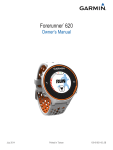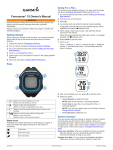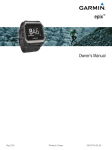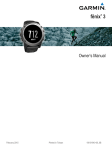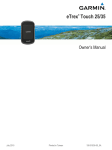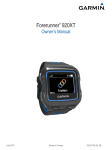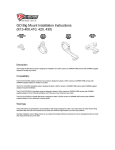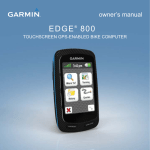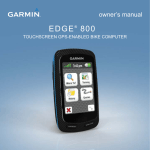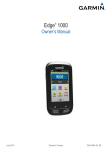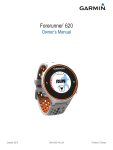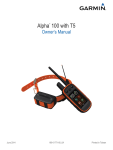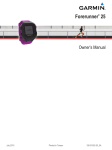Download Forerunner® 630
Transcript
Forerunner 630 ® Owner’s Manual November 2015 190-01954-00_0B All rights reserved. Under the copyright laws, this manual may not be copied, in whole or in part, without the written consent of Garmin. Garmin reserves the right to change or improve its products and to make changes in the content of this manual without obligation to notify any person or organization of such changes or improvements. Go to www.garmin.com for current updates and supplemental information concerning the use of this product. Garmin , the Garmin logo, ANT+ , Auto Lap , Auto Pause , Forerunner , VIRB , and Virtual Partner are trademarks of Garmin Ltd. or its subsidiaries, registered in the USA and other countries. Connect IQ™, Garmin Connect™, Garmin Express™, HRM-Run™, HRM-Tri™, and tempe™ are trademarks of Garmin Ltd. or its subsidiaries. These trademarks may not be used without the express permission of Garmin. ® ® ® ® ® ® ® Android™ is a trademark of Google, Inc. Apple and Mac are trademarks of Apple Inc., registered in the U.S. and other countries. The Bluetooth word mark and logos are owned by the Bluetooth SIG, Inc. and any use of such marks by Garmin is under license. The Cooper Institute , as well as any related trademarks, are the property of The Cooper Institute. Firstbeat and Analyzed by Firstbeat are registered or unregistered trademarks of Firstbeat Technologies Ltd. Windows is a registered trademark of Microsoft Corporation in the United States and other countries. Wi‑Fi is a registered mark of Wi-Fi Alliance Corporation. Other trademarks and trade names are those of their respective owners. ® ® ® ® ® ® This product is ANT+ certified. Visit www.thisisant.com/directory for a list of compatible products and apps. ® M/N: A02758, A02293 Table of Contents Navigating Back to Start ............................................................. 7 Stopping Navigation .................................................................... 7 Introduction.....................................................................1 ANT+ Sensors................................................................. 7 Keys ............................................................................................ 1 Status Icons ........................................................................... 1 Touchscreen Tips ....................................................................... 1 Going for a Run .......................................................................... 1 Pairing ANT+ Sensors ................................................................ 7 Running Dynamics ...................................................................... 7 Training with Running Dynamics ........................................... 7 Color Gauges and Running Dynamics Data .......................... 7 Tips for Missing Running Dynamics Data .............................. 8 Setting Your Heart Rate Zones ................................................... 8 Letting the Device Set Your Heart Rate Zones .......................... 8 Physiological Measurements ...................................................... 8 About VO2 Max. Estimates .................................................... 9 Viewing Your Predicted Race Times ..................................... 9 Recovery Advisor ................................................................... 9 Recovery Heart Rate ............................................................. 9 Lactate Threshold .................................................................. 9 Viewing Your Performance Condition .................................. 10 Viewing Your Stress Score .................................................. 10 Foot Pod ................................................................................... 10 Going for a Run Using a Foot Pod ....................................... 10 Foot Pod Calibration ............................................................ 10 Training........................................................................... 1 Activity Tracking .......................................................................... 1 Turning On Activity Tracking .................................................. 1 Using the Move Alert .............................................................. 1 Auto Goal ............................................................................... 2 Using Do Not Disturb Mode ................................................... 2 Sleep Tracking ....................................................................... 2 Training Indoors .......................................................................... 2 Workouts ..................................................................................... 2 Following a Workout From the Web ....................................... 2 Starting a Workout ................................................................. 2 About the Training Calendar .................................................. 2 Interval Workouts ........................................................................ 2 Creating an Interval Workout ................................................. 2 Starting an Interval Workout .................................................. 3 Stopping a Workout ............................................................... 3 Using Virtual Partner® ................................................................ 3 Setting a Training Target ............................................................ 3 Cancelling a Training Target .................................................. 3 Racing a Previous Activity .......................................................... 3 Personal Records ....................................................................... 3 Viewing Your Personal Records ............................................ 3 Restoring a Personal Record ................................................. 3 Clearing a Personal Record ................................................... 3 Clearing All Personal Records ............................................... 3 Smart Features ............................................................... 4 Pairing Your Smartphone ........................................................... 4 Phone Notifications ................................................................ 4 Playing Audio Alerts During Your Run ................................... 4 Widgets ....................................................................................... 4 Bluetooth Controls Widget ..................................................... 4 Viewing the Weather Widget .................................................. 4 VIRB Remote ......................................................................... 4 Bluetooth Connected Features ................................................... 5 Turning On the Smartphone Connection Alert ....................... 5 Locating a Lost Smartphone .................................................. 5 Turning Off Bluetooth Technology ......................................... 5 Connect IQ™ Features ............................................................... 5 Downloading Connect IQ Features ........................................ 5 Wi‑Fi Connected Features .......................................................... 5 Setting Up Wi‑Fi Connectivity on Your Forerunner Device ................................................................. 5 Turning Off Wi‑Fi Wireless Technology ................................. 5 History ............................................................................. 5 Viewing History ........................................................................... 5 Viewing Your Time in Each Heart Rate Zone ........................ 6 Viewing Data Totals .................................................................... 6 Deleting History .......................................................................... 6 Data Management ...................................................................... 6 Deleting Files ......................................................................... 6 Disconnecting the USB Cable ................................................ 6 Sending Data to Your Garmin Connect Account ........................ 6 Garmin Connect .......................................................................... 6 Navigation....................................................................... 6 Viewing and Saving Your Location ............................................. 6 Editing a Location .................................................................. 6 Deleting a Location ................................................................ 7 Navigating to a Saved Location .................................................. 7 Table of Contents Customizing Your Device............................................ 10 Setting Up Your User Profile ..................................................... 10 Activity Profiles ......................................................................... 10 Changing Your Activity Profile ............................................. 11 Creating a Custom Activity Profile ....................................... 11 Deleting an Activity Profile ................................................... 11 Activity Settings ........................................................................ 11 Customizing the Data Screens ............................................ 11 Alerts .................................................................................... 11 Running with the Metronome ............................................... 11 Using Auto Pause® ............................................................. 12 Marking Laps by Distance .................................................... 12 Customizing the Lap Alert Message .................................... 12 Using Auto Scroll ................................................................. 12 Changing the GPS Setting ................................................... 12 Using UltraTrac Mode .......................................................... 12 Power Save Timeout Settings .............................................. 12 Activity Tracking Settings .......................................................... 12 System Settings ........................................................................ 12 Changing the Device Language .......................................... 12 Time Settings ....................................................................... 12 Backlight Settings ................................................................ 13 Setting the Device Sounds .................................................. 13 Changing the Units of Measure ........................................... 13 Format Settings .................................................................... 13 Data Recording Settings ...................................................... 13 Device Information ....................................................... 13 Charging the Device ................................................................. 13 Specifications ............................................................................ 13 Forerunner Specifications .................................................... 13 HRM-Run Specifications ...................................................... 13 Device Care .............................................................................. 13 Cleaning the Device ............................................................. 14 Caring for the Heart Rate Monitor ........................................ 14 User Replaceable Batteries ................................................. 14 Troubleshooting........................................................... 14 Support and Updates ................................................................ 14 Getting More Information .......................................................... 14 Acquiring Satellite Signals ........................................................ 14 Improving GPS Satellite Reception .......................................... 14 Resetting the Device ................................................................. 14 Clearing User Data ................................................................... 14 Restoring All Default Settings ................................................... 15 Viewing Device Information ...................................................... 15 i Updating the Software .............................................................. 15 Maximizing Battery Life ............................................................. 15 Locking the Touchscreen and Keys ......................................... 15 My daily step count does not appear ........................................ 15 Tips for Erratic Heart Rate Data ............................................... 15 Appendix....................................................................... 15 Data Fields ................................................................................ 15 Software License Agreement ................................................... 16 Heart Rate Zone Calculations ................................................... 16 VO2 Max. Standard Ratings ..................................................... 16 Index.............................................................................. 18 ii Table of Contents Introduction WARNING See the Important Safety and Product Information guide in the product box for product warnings and other important information. Always consult your physician before you begin or modify any exercise program. Keys À Select to turn the backlight on and off. Hold to turn the device on and off. Á Select to start and stop the timer. Select to access the activity profiles and apps.  Select to mark a new lap. Ã Ä • Swipe right to exit a menu. • Perform each touchscreen selection as a separate action. Going for a Run The first fitness activity you record on your device can be a run, ride, or any outdoor activity. You may need to charge the device (Charging the Device, page 13) before starting the activity. 1 Select , and select an activity profile. 2 Go outside, and wait while the device locates satellites. 3 Select to start the timer. 4 Go for a run. 5 After you complete your run, select 6 Select an option: to stop the timer. • Select Save to save the run and reset the timer. You can select the run to view a summary. Select to open the menu. TIP: The menu options depend on the active screen and how you are using the device. Select to return to the previous screen. Hold to lock the device keys and touchscreen. Status Icons Icons appear at the top of the home screen. A flashing icon means the device is searching for a signal. A solid icon means the signal was found or the sensor is connected. GPS status • Select • Select > to delete the run. to resume the run. Bluetooth technology status ® Training Wi‑Fi technology status ® Heart rate status Activity Tracking Foot pod status Turning On Activity Tracking Speed and cadence sensor status The activity tracking feature records your daily step count, step goal, distance traveled, and calories burned for each recorded day. Your calories burned includes your base metabolism plus activity calories. Activity tracking can be enabled during the initial device setup, or at any time. > Settings > Activity Tracking > Status > On. 1 Select Your step count does not appear until the device locates satellites and sets the time automatically. The device may need a clear view of the sky to locate satellite signals. 2 From the time of day screen, swipe to view the activity tracking widget. The step count is updated periodically. tempe™ sensor status VIRB camera status ® Touchscreen Tips NOTE: The touchscreen is optimized for running. For best results, you should wear the device while operating the touchscreen. • From the watch face, swipe left or right to scroll through the available widgets. • From the timer screen, swipe left or right to view data screens in the loop. • From a data screen, hold a data field to change it. • Tap the touchscreen to confirm messages and alerts. • Swipe up or down to scroll through menus, options, and settings. • Select to close a message or confirm a choice. • Select to cancel a setting or choice without saving. Introduction Using the Move Alert Before you can use the move alert, you must turn on activity tracking. Sitting for prolonged periods of time can trigger undesirable metabolic state changes. The move alert reminds you to keep moving. After one hour of inactivity, Move! and the red bar 1 appear. The device also beeps or vibrates if audible tones are turned on (Setting the Device Sounds, page 13). Go for a short walk (at least a couple of minutes) to reset the move alert. Auto Goal Your device creates a daily step goal automatically, based on your previous activity levels. As you move during the day, the device shows your progress toward your daily goal À. Following a Workout From the Web Before you can download a workout from Garmin Connect, you must have a Garmin Connect account (Garmin Connect, page 6). 1 Connect the device to your computer. 2 Go to www.garminconnect.com. 3 Create and save a new workout. 4 Select Send to Device, and follow the on-screen instructions. 5 Disconnect the device. Starting a Workout If you choose not to use the auto goal feature, you can set a personalized step goal on your Garmin Connect™ account. Before you can start a workout, you must download a workout from your Garmin Connect account. > Training > My Workouts. 1 Select 2 Select a workout. 3 Select Do Workout. After you begin a workout, the device displays each step of the workout, the target (if any), and current workout data. Using Do Not Disturb Mode About the Training Calendar Before you can use do not disturb mode, you must pair your device with a smartphone (Pairing Your Smartphone, page 4). You can use do not disturb mode to turn off the backlight, alert tones, and vibrations. For example, you can use this mode while sleeping or watching a movie. NOTE: You can set your normal sleep hours in the user settings on your Garmin Connect account. The device automatically enters do not disturb mode during your normal sleep hours. From the time of day screen, swipe right to view the controls widget, and select . You can turn off do not disturb mode from the controls widget. Sleep Tracking While you are sleeping, the device monitors your movement. Sleep statistics include total hours of sleep, sleep levels, and sleep movement. You can set your normal sleep hours in the user settings on your Garmin Connect account. You can view your sleep statistics on your Garmin Connect account. Training Indoors The device includes indoor activity profiles where GPS is turned off. You can turn off GPS when you are training indoors or to save battery life. NOTE: Any change to the GPS setting is saved to the active profile. Select > Activity Settings > GPS > Off. When running with GPS turned off, speed and distance are calculated using the accelerometer in the device. The accelerometer is self-calibrating. The accuracy of the speed and distance data improves after a few outdoor runs using GPS. Workouts You can create custom workouts that include goals for each workout step and for varied distances, times, and calories. You can create workouts using Garmin Connect or select a training plan that has built-in workouts from Garmin Connect, and transfer them to your device. You can schedule workouts using Garmin Connect. You can plan workouts in advance and store them on your device. 2 The training calendar on your device is an extension of the training calendar or schedule you set up in Garmin Connect. After you have added a few workouts to the Garmin Connect calendar, you can send them to your device. All scheduled workouts sent to the device appear in the training calendar list by date. When you select a day in the training calendar, you can view or do the workout. The scheduled workout stays on your device whether you complete it or skip it. When you send scheduled workouts from Garmin Connect, they overwrite the existing training calendar. Using Garmin Connect Training Plans Before you can download and use a training plan, you must have a Garmin Connect account (Garmin Connect, page 6). You can browse your Garmin Connect account to find a training plan, schedule workouts, and send them to your device. 1 Connect the device to your computer. 2 From your Garmin Connect account, select and schedule a training plan. 3 Review the training plan in your calendar. 4 Select , and follow the on-screen instructions. Interval Workouts You can create interval workouts based on distance or time. The device saves your custom interval workout until you create another interval workout. You can use open intervals for track workouts and when you are running a known distance. When , the device records an interval and moves to a you select rest interval. Creating an Interval Workout > Training > Intervals > Edit > Interval > Type. 1 Select 2 Select Distance, Time, or Open. 3 4 5 6 7 TIP: You can create an open-ended interval by setting the type to Open. Select Duration, enter a distance or time interval value for the workout, and select . Select Rest > Type. Select Distance, Time, or Open. If necessary, enter a distance or time value for the rest interval, and select . Select one or more options: • To set the number of repetitions, select Repeat. Training • To add an open-ended warm up to your workout, select Warm Up > On. • To add an open-ended cool down to your workout, select Cool Down > On. Starting an Interval Workout > Training > Intervals > Do Workout. 1 Select Select . 2 3 When your interval workout has a warm up, select to begin the first interval. 4 Follow the on-screen instructions. When you complete all of the intervals, a message appears. Stopping a Workout • At any time, select • At any time, select • At any time, select workout. to end a workout step. to stop the timer. > Cancel Workout to end the Using Virtual Partner ® The Virtual Partner feature is a training tool designed to help you meet your goals. You can set the Virtual Partner pace or speed to help you reach your training target. > Settings > Activity Settings > Data Screens > 1 Select Virtual Partner > Status > On. 2 Select Set Pace or Set Speed. You can use pace or speed as your running format. 3 Go for a run. 4 Scroll to the Virtual Partner screen to see who is leading. 3 Select to start the timer. 4 If necessary, swipe to view the Virtual Partner screen. 5 After you complete your activity, select > Save. A summary screen appears indicating that you finished ahead of or behind the target. Cancelling a Training Target 1 During the activity, swipe to view the target screen. 2 Hold . 3 Select Cancel Target > . Racing a Previous Activity You can race a previously recorded or downloaded activity. This feature can be used with the running, cycling, and other single sport activity profiles (excludes swimming). This feature works with the Virtual Partner feature so you can see how far ahead or behind you are during the activity. > Training > Race an Activity. 1 Select 2 Select an option: • Select From History to select a previously recorded activity from your device. • Select Downloaded to select an activity you downloaded from your Garmin Connect account. 3 Select the activity. The Virtual Partner screen displays your estimated finish time. 4 Select to start the timer. 5 After you complete your activity, select > Save. A summary screen appears indicating that you finished the race ahead of or behind the previously recorded or downloaded activity. Personal Records When you complete an activity, the device displays any new personal records you achieved during that activity. Personal records include your fastest time over several typical race distances and longest run or ride. 5 If necessary, hold the Virtual Partner banner À to adjust Virtual Partner pace or speed during your run. Setting a Training Target The training target feature works with the Virtual Partner feature so you can train toward a set distance, distance and time, distance and pace, or distance and speed goal. This feature can be used with the running, cycling, and other single sport activity profiles (excludes swimming). During your training activity, the device gives you real-time feedback about how close you are to achieving your training target. > Training > Set a Target. 1 Select 2 Select an option: • Select Distance Only to select a preset distance or enter a custom distance. • Select Distance and Time to select a distance and time target. You can enter the time target, use prediction (based on your VO2 max. estimate), or use your personal record time. • Select Distance and Pace or Distance and Speed to select a distance and pace or speed target. The training target screen displays your estimated finish time. The estimated finish time is based on your current performance and the time remaining. Training Viewing Your Personal Records > My Stats > Records. 1 Select 2 Select a sport. 3 Select a record. 4 Select View Record. Restoring a Personal Record You can set each personal record back to the one previously recorded. > My Stats > Records. 1 Select Select a sport. 2 3 Select a record to restore. 4 Select Previous > . NOTE: This does not delete any saved activities. Clearing a Personal Record > My Stats > Records. 1 Select 2 Select a sport. 3 Select a record to delete. 4 Select Clear Record > . NOTE: This does not delete any saved activities. Clearing All Personal Records > My Stats > Records. 1 Select NOTE: This does not delete any saved activities. 3 2 Select a sport. 3 Select Clear All Records > 1 From the settings in the Garmin Connect Mobile app, select . The records are deleted only for that sport. Smart Features Pairing Your Smartphone You should connect your Forerunner device to a smartphone to complete the setup and use the full features of the device. 1 Go to www.garmin.com/intosports/apps, and download the Garmin Connect Mobile app to your smartphone. > Settings > 2 From the Forerunner device, select Bluetooth > Pair Mobile Device. 3 Open the Garmin Connect Mobile app. 4 Select an option to add your device to your Garmin Connect account: • If this is the first device you have paired with the Garmin Connect Mobile app, follow the on-screen instructions. • If you have already paired another device with the Garmin Connect Mobile app, from the settings, select Garmin Devices > , and follow the on-screen instructions. Phone Notifications Phone notifications require a compatible smartphone to be paired with the Forerunner device. When your phone receives messages, it sends notifications to your device. Enabling Bluetooth Notifications > Settings > Bluetooth > Smart Notifications. 1 Select 2 Select During Activity. 3 Select Off, Show Calls Only, or Show All. 4 Select Not During Activity. 5 Select Off, Show Calls Only, or Show All. NOTE: You can change the audible sounds for notifications. Viewing Notifications • When a notification appears on your Forerunner device, tap the touchscreen to view the notification. • Select the on-screen button to clear the notification or view more options. • From the time of day screen, swipe to view all of your notifications on the notifications widget. Managing Notifications You can use your compatible smartphone to manage notifications that appear on your Forerunner device. Select an option: • If you are using an Apple device, use the notification center settings on your smartphone to select the items to show on the device. • If you are using an Android™ device, use the app settings in the Garmin Connect Mobile app to select the items to show on the device. ® Playing Audio Alerts During Your Run Before you can set up audio alerts, you must have a smartphone with the Garmin Connect Mobile app paired to your Forerunner device. You can set the Garmin Connect Mobile app to play motivational status announcements on your smartphone during the run. Audio alerts include the lap number and lap time, pace or speed, and heart rate data. During an audio alert, the Garmin Connect mobile app mutes the primary audio of the smartphone to play the announcement. Volume levels can be customized on the Garmin Connect Mobile app. 4 Garmin Devices. 2 Select your device. 3 If necessary, select Device Settings. 4 Select Audio Alerts. Widgets Your device comes preloaded with widgets that provide at-aglance information. Some widgets require a Bluetooth connection to a compatible smartphone. Notifications: Alerts you to incoming calls and texts based on your smartphone notification settings. Calendar: Displays upcoming meetings from your smartphone calendar. Music controls: Provides music player controls for your smartphone. Weather: Displays the current temperature and weather forecast. Activity Tracking: Tracks your daily step count, step goal, distance traveled, calories burned, and sleep statistics. Controls: Allows you to turn on and off the Bluetooth connectivity and features including do not disturb, find my phone, and manual syncing. VIRB controls: Provides camera controls when you have a VIRB device paired with your Forerunner device. Bluetooth Controls Widget Turns on or off do not disturb mode. Turns on or off Bluetooth technology. Sync Synchronizes your data with the Garmin Connect Mobile app. Activates the find my phone feature. It sends a beacon to your smartphone that is paired and in range of your Forerunner device. Viewing the Weather Widget 1 From the time of day screen, swipe right to view the weather widget. 2 Tap the touchscreen to view hourly and daily weather data. 3 Scroll down to view daily weather data. VIRB Remote The VIRB remote function allows you to control your VIRB action camera using your device. Go to www.garmin.com/VIRB to purchase a VIRB action camera. Controlling a VIRB Action Camera Before you can use the VIRB remote function, you must enable the remote setting on your VIRB camera. See the VIRB Series Owner's Manual for more information. 1 Turn on your VIRB camera. 2 Pair the VIRB camera with your Forerunner device (Pairing ANT+ Sensors, page 7). 3 On the Forerunner device, select the VIRB accessory. When the VIRB accessory is paired, the VIRB screen is added to the data screens for the active profile. 4 Select an option: • Select Timer Start/Stop to control the camera using the timer . Video recording automatically starts and stops with the Forerunner device timer. • Select Manual to control the camera using the VIRB widget. Smart Features 1 From the settings in the Garmin Connect Mobile app, select Bluetooth Connected Features The Forerunner device has several Bluetooth connected features for your compatible smartphone using the Garmin Connect Mobile app. For more information, go to www.garmin.com/intosports/apps. LiveTrack: Allows friends and family to follow your races and training activities in real time. You can invite followers using email or social media, allowing them to view your live data on a Garmin Connect tracking page. Activity uploads: Automatically sends your activity to the Garmin Connect Mobile app as soon as you finish recording the activity. Software updates: Your device wirelessly downloads the latest software update. The next time you turn on the device, you can follow the on-screen instructions to update the software. Workout downloads: Allows you to browse for workouts in the Garmin Connect Mobile app and wirelessly send them to your device. Social media interactions: Allows you to post an update to your favorite social media website when you upload an activity to the Garmin Connect Mobile app. Notifications: Displays phone notifications and messages on your Forerunner device. Turning On the Smartphone Connection Alert You can set the Forerunner device to alert you when your paired smartphone connects and disconnects using Bluetooth wireless technology. Select > Settings > Bluetooth > Connection Alert > On. Locating a Lost Smartphone You can use the find my phone feature to help locate a lost smartphone that is paired using Bluetooth wireless technology and currently within range. 1 From the time of day screen, swipe to view the controls widget, and select . The Forerunner device begins searching for your paired smartphone. Bars appear on the Forerunner device screen corresponding to the Bluetooth signal strength, and an audible alert sounds on your smartphone. 2 Select to stop searching. Turning Off Bluetooth Technology From the time of day screen, swipe right to view the controls widget, and select . is gray when Bluetooth technology is turned off. Connect IQ Features ™ You can add Connect IQ features to your watch from Garmin and other providers using the Garmin Connect Mobile app. You can customize your device with watch faces, data fields, widgets, and apps. Watch Faces: Allow you to customize the appearance of the clock. Data Fields: Allow you to download new data fields that present sensor, activity, and history data in new ways. You can add Connect IQ data fields to built-in features and pages. Widgets: Provide information at a glance, including sensor data and notifications. Apps: Add interactive features to your watch, such as new outdoor and fitness activity types. ® Downloading Connect IQ Features Before you can download Connect IQ features from the Garmin Connect Mobile app, you must pair your Forerunner device with your smartphone. History Connect IQ Store. 2 If necessary, select your device. 3 Select a Connect IQ feature. 4 Follow the on-screen instructions. Downloading Connect IQ Features Using Your Computer 1 Connect the device to your computer using a USB cable. 2 Go to www.garminconnect.com. 3 From your devices widget, select Connect IQ Store. 4 Select a Connect IQ feature. 5 Select Send to Device, and follow the on-screen instructions. Wi‑Fi Connected Features The Forerunner device has Wi‑Fi connected features. The Garmin Connect Mobile application is not required for you to use Wi‑Fi connectivity. NOTE: Your device must be connected to a wireless network to take advantage of these features. Activity uploads to Garmin Connect: Automatically sends your activity to Garmin Connect as soon as you finish recording. Workouts and training plans: Activities and training plans previously selected from Garmin Connect are sent wirelessly to your device. Software updates: Your device wirelessly downloads the latest software update. The next time you turn on the device, you can follow the on-screen instructions to update the software. Setting Up Wi‑Fi Connectivity on Your Forerunner Device Before you can upload an activity wirelessly, you must have an activity saved to your device, and the timer must be stopped. 1 Go to www.garminconnect.com/start, and download the Garmin Express™ application. 2 In the Garmin Express application, follow the on-screen instructions to add your device. 3 In the Garmin Express application, select Tools. 4 Follow the on-screen instructions to set up a Wi‑Fi network. TIP: You can register your device at this time. Your device attempts to upload your saved activity to your Garmin Connect account following each activity. Turning Off Wi‑Fi Wireless Technology • From the Forerunner device, select > Settings > Wi-Fi > Auto Upload > Off. • Refer to the owner's manual for your mobile device to turn off Wi‑Fi wireless technology. History History includes time, distance, calories, average pace or speed, lap data, and optional ANT+ sensor information. NOTE: When the device memory is full, your oldest data is overwritten. ® Viewing History 1 2 3 4 Select > History > Activities. Scroll up and down to view your saved activities. Select an activity. Select an option: • Select Details to view additional information about the activity. 5 • Select Laps to select a lap and view additional information about each lap. • Select Time in Zone to view your time in each heart rate zone. • Select Delete to delete the selected activity. Viewing Your Time in Each Heart Rate Zone Before you can view heart rate zone data, you must pair your device with a compatible heart rate monitor, complete an activity, and save the activity. Viewing your time in each heart rate zone can help you adjust your training intensity. > History > Activities. 1 Select 2 Select an activity. 3 Select Time in Zone. Viewing Data Totals You can view the accumulated distance and time data saved to your device. > History > Totals. 1 Select 2 Select an option to view weekly or monthly totals. 1 Connect the device to your computer using the USB cable. 2 Go to www.garminconnect.com/start. 3 Follow the on-screen instructions. Garmin Connect You can connect with your friends on Garmin Connect. Garmin Connect gives you the tools to track, analyze, share, and encourage each other. Record the events of your active lifestyle including runs, walks, rides, swims, hikes, triathlons, and more. To sign up for a free account, go to www.garminconnect.com /start. Store your activities: After you complete and save an activity with your device, you can upload that activity to your Garmin Connect account and keep it as long as you want. Analyze your data: You can view more detailed information about your activity, including time, distance, elevation, heart rate, calories burned, cadence, running dynamics, an overhead map view, pace and speed charts, and customizable reports. NOTE: Some data requires an optional accessory such as a heart rate monitor. Deleting History > History > Options. 1 Select 2 Select an option: • Select Delete All Activities to delete all activities from the history. • Select Reset Totals to reset all distance and time totals. NOTE: This does not delete any saved activities. 3 Confirm your selection. Data Management NOTE: The device is not compatible with Windows 95, 98, Me, Windows NT , and Mac OS 10.3 and earlier. ® ® ® Deleting Files NOTICE If you do not know the purpose of a file, do not delete it. Your device memory contains important system files that should not be deleted. 1 2 3 4 Open the Garmin drive or volume. If necessary, open a folder or volume. Select a file. Press the Delete key on your keyboard. Disconnecting the USB Cable Plan your training: You can choose a fitness goal and load one of the day-by-day training plans. Track your progress: You can track your daily steps, join a friendly competition with your connections, and meet your goals. Share your activities: You can connect with friends to follow each other's activities or post links to your activities on your favorite social networking sites. Manage your settings: You can customize your device and user settings on your Garmin Connect account. Access the Connect IQ store: You can download apps, watch faces, data fields, and widgets. Navigation If your device is connected to your computer as a removable drive or volume, you must safely disconnect your device from your computer to avoid data loss. If your device is connected to your Windows computer as a portable device, it is not necessary to safely disconnect. 1 Complete an action: • For Windows computers, select the Safely Remove Hardware icon in the system tray, and select your device. • For Mac computers, drag the volume icon to the trash. 2 Disconnect the cable from your computer. Viewing and Saving Your Location Sending Data to Your Garmin Connect Account Editing a Location You can upload all of your activity data to your Garmin Connect account for comprehensive analysis. You can view a map of your activity and share your activities with friends. 6 Before you can view location information, your device must locate satellites. A location is a point that you record and store in the device. If you want to remember landmarks or return to a certain spot, you can save your current location. 1 Go to the place where you want to mark a location. > Locations > Where Am I?. 2 Select Your device displays your current elevation and coordinates. 3 If necessary, select Save Location. You can edit the name of the saved location. > Locations > Saved Locations. 1 Select 2 Select a location. 3 Select Name. Navigation 4 Edit the name, and select Running Dynamics . Deleting a Location > Locations > Saved Locations. 1 Select 2 Select a location. 3 Select Delete > . Navigating to a Saved Location Before you can navigate to a saved location, your device must locate satellites. > Locations > Saved Locations. 1 Select 2 Select a location. 3 Select Go To. The compass appears. The arrow points toward the saved location. 4 Select to start the timer and record the activity. Navigating Back to Start At any point during your activity, you can return to your starting location. For example, if you are running in a new city, and you are unsure how to get back to the trail head or hotel, you can navigate back to your starting location. Select an option: • If the timer is still running, select > Back to Start. • If you stopped the timer and you have not saved your activity, select > Back to Start. • If you stopped the timer and saved your activity, select > Locations > Back to Start. The device navigates you to the starting location of the last saved activity. The compass appears. The arrow points toward your starting point. If the timer is not running, you can start the timer again to prevent the device from timing out to watch mode. Stopping Navigation Select > Stop Navigation > . ANT+ Sensors You can use your compatible Forerunner device paired with the HRM-Run™ accessory to provide real-time feedback about your running form. If your Forerunner device was packaged with the HRM-Run accessory, the devices are already paired. The HRM-Run accessory has an accelerometer in the module that measures torso movement in order to calculate six running metrics. Cadence: Cadence is the number of steps per minute. It displays the total steps (right and left combined). Vertical oscillation: Vertical oscillation is your bounce while running. It displays the vertical motion of your torso, measured in centimeters for each step. Ground contact time: Ground contact time is the amount of time in each step that you spend on the ground while running. It is measured in milliseconds. NOTE: Ground contact time is not available while walking. Ground contact time balance: Ground contact time balance displays the left/right balance of your ground contact time while running. It displays a percentage. For example, 53.2 with an arrow pointing left or right. Stride length: Stride length is the length of your stride from one footfall to the next. It is measured in meters. Vertical ratio: Vertical ratio is the ratio of vertical oscillation to stride length. It displays a percentage. A lower number typically indicates better running form. Training with Running Dynamics Before you can view running dynamics, you must put on the HRM-Run accessory or HRM-Tri™ accessory and pair it with your device (Pairing ANT+ Sensors, page 7). If your Forerunner was packaged with the heart rate monitor, the devices are already paired, and the Forerunner is set to display running dynamics. 1 Select , and select a running activity profile. 2 Select . 3 Go for a run. 4 Scroll to the running dynamics screens to view your metrics. Your device can be used with wireless ANT+ sensors. For more information about compatibility and purchasing optional sensors, go to http://buy.garmin.com. Pairing ANT+ Sensors Pairing is the connecting of ANT+ wireless sensors, for example, connecting a heart rate monitor with your Garmin device. The first time you connect an ANT+ sensor to your device, you must pair the device and sensor. After the initial pairing, the device automatically connects to the sensor when you start your activity and the sensor is active and within range. NOTE: If your device was packaged with an ANT+ sensor, they are already paired. 1 Install the sensor or put on the heart rate monitor. 2 Bring the device within 1 cm of the sensor, and wait while the device connects to the sensor. When the device detects the sensor, a message appears. You can customize a data field to display sensor data. > Settings > Sensors and 3 If necessary, select Accessories to manage ANT+ sensors. 5 If necessary, hold a data field to edit how the running dynamics data appears. Color Gauges and Running Dynamics Data The running dynamics screens display a color gauge for the primary metric. You can display cadence, vertical oscillation, ground contact time, ground contact time balance, or vertical ratio as the primary metric. The color gauge shows you how your running dynamics data compare to those of other runners. The color zones are based on percentiles. ANT+ Sensors 7 Garmin has researched many runners of all different levels. The data values in the red or orange zones are typical for less experienced or slower runners. The data values in the green, blue, or purple zones are typical for more experienced or faster runners. More experienced runners tend to exhibit shorter ground contact times, lower vertical oscillation, lower vertical ratio, and higher cadence than less experienced runners. However, taller runners typically have slightly slower cadences, longer strides, and slightly higher vertical oscillation. Vertical ratio is your vertical oscillation divided by stride length. It is not correlated with height. NOTE: The color gauge for ground contact time balance is different (Ground Contact Time Balance Data, page 8). Go to www.garmin.com for more information on running dynamics. For additional theories and interpretations of running dynamics data, you can search reputable running publications and websites. Color Zone Percentile in Zone Cadence Range Vertical Oscillation Range Vertical Ratio Ground Contact Time Range Purple >95 >183 spm <6.4 cm <6.1% <218 ms Blue 70–95 174–183 spm 6.4–8.1 cm 6.1–7.4% 218–248 ms Green 30–69 164–173 spm 8.2–9.7 cm 7.5–8.6% 249–277 ms Orange 5–29 153–163 spm 9.8–11.5 cm 8.7–10.1% 278–308 ms Red <153 spm >11.5 cm >10.1% >308 ms <5 Ground Contact Time Balance Data Ground contact time balance measures your running symmetry and appears as a percentage of your total ground contact time. For example, 51.3% with an arrow pointing left indicates the runner is spending more time on the ground when on the left foot. If your data screen displays both numbers, for example 48–52, 48% is the left foot and 52% is the right foot. Color Zone Red Orange Green Orange Red Symmetry Poor Fair Good Fair Poor Percent of Other Runners 5% 25% 40% 25% 5% Ground Contact Time Balance >52.2% L 50.8–52.2% L 50.7% L–50.7% R 50.8–52.2% R >52.2% R While developing and testing running dynamics, the Garmin team found correlations between injuries and greater imbalances with certain runners. For many runners, ground contact time balance tends to deviate further from 50–50 when running up or down hills. Most running coaches agree that a symmetrical running form is good. Elite runners tend to have quick and balanced strides. You can watch the color gauge or data field during your run or view the summary on your Garmin Connect account after your run. As with the other running dynamics data, ground contact time balance is a quantitative measurement to help you learn about your running form. • Select %Max. HR to view and edit the zones as a Tips for Missing Running Dynamics Data percentage of your maximum heart rate. If running dynamics data does not appear, you can try these tips. • Select %HRR to view and edit the zones as a percentage of your heart rate reserve (maximum heart rate minus • Make sure you have the HRM-Run accessory. resting heart rate). Accessories with running dynamics have on the front of the • Select %LTHR to view and edit the zones as a percentage module. of your lactate threshold heart rate. • Pair the HRM-Run accessory with your Forerunner 630 7 Select a zone, and enter a value for each heart rate zone. device again, according to the instructions. • If the running dynamics data display shows only zeros, make sure the heart rate monitor is worn right-side up. NOTE: Ground contact time appears only while running. It is not calculated while walking. Setting Your Heart Rate Zones The device uses your user profile information from the initial setup to determine your default heart rate zones. You can manually enter heart rate values and set the range for each zone. > My Stats > User Profile > Heart Rate Zones. 1 Select 2 Select Max. HR. You can use the Auto Detect feature to automatically record your maximum heart rate during an activity, or you can manually enter your maximum heart rate. 3 Select LTHR, and enter your lactate threshold heart rate. You can do a guided test to estimate your lactate threshold (Lactate Threshold, page 9). 4 Select Resting HR, and enter your resting heart rate. 5 Select Zones > Based On. 6 Select an option: • Select BPM to view and edit the zones in beats per minute. 8 Letting the Device Set Your Heart Rate Zones The default settings allow the device to detect your maximum heart rate and set your heart rate zones as a percentage of your maximum heart rate. • Verify that your user profile settings are accurate (Setting Up Your User Profile, page 10). • Run often with your compatible heart rate monitor. • Try a few heart rate training plans, available from your Garmin Connect account. • View your heart rate trends and time in zones using your Garmin Connect account. Physiological Measurements These physiological measurements require a compatible heart rate monitor. The measurements are estimates that can help you track and understand your training runs and race performances. NOTE: The estimates may seem inaccurate at first. The device requires a few runs to learn about your running performance. VO2 max.: VO2 max. is the maximum volume of oxygen (in milliliters) you can consume per minute per kilogram of body weight at your maximum performance. ANT+ Sensors Predicted race times: Your device uses the VO2 max. estimate and published data sources to provide a target race time based on your current state of fitness. This projection also presumes you have completed the proper training for the race. Recovery advisor: The recovery advisor displays how much time remains before you are fully recovered and ready for the next hard workout. Stress score: Stress score measures your heart rate variability while standing still for 3 minutes. It provides your overall stress level. The scale is 1 to 100, and a lower score indicates a lower stress level. Performance condition: Your performance condition is a realtime assessment after running for 6 to 20 minutes. It can be added as a data field so you can view your performance condition during the rest of your run. It compares your realtime condition to your average fitness level. Lactate threshold: Lactate threshold is the point where your muscles start to rapidly fatigue. Your device measures your lactate threshold level using heart rate and pace. About VO2 Max. Estimates VO2 max. is the maximum volume of oxygen (in milliliters) you can consume per minute per kilogram of body weight at your maximum performance. In simple terms, VO2 max. is an indication of athletic performance and should increase as your level of fitness improves. VO2 max. estimates are provided and supported by Firstbeat Technologies Ltd. You can use your Garmin device paired with a compatible heart rate monitor to display your running VO2 max. estimate. Your VO2 max. estimate appears as a number and position on the color gauge. Purple Superior Blue Excellent Green Good Orange Fair Red Poor VO2 max. data and analysis is provided with permission from The Cooper Institute . For more information, see the appendix (VO2 Max. Standard Ratings, page 16), and go to www.CooperInstitute.org. ® Getting Your VO2 Max. Estimate for Running This feature requires a heart rate monitor. For the most accurate estimate, complete the user profile setup (Setting Up Your User Profile, page 10), and set your maximum heart rate (Setting Your Heart Rate Zones, page 8). The estimate may seem inaccurate at first. The device requires a few runs to learn about your running performance. 1 Run for at least 10 minutes outdoors. 2 After your run, select Save. > My Stats > VO2 Max.. 3 Select Viewing Your Predicted Race Times This feature requires a heart rate monitor. ANT+ Sensors For the most accurate estimate, complete the user profile setup (Setting Up Your User Profile, page 10), and set your maximum heart rate (Setting Your Heart Rate Zones, page 8). Your device uses the VO2 max. estimate (About VO2 Max. Estimates, page 9) and published data sources to provide a target race time based on your current state of fitness. This projection also presumes you have completed the proper training for the race. NOTE: The projections may seem inaccurate at first. The device requires a few runs to learn about your running performance. > My Stats > Race Predictor. Select Your projected race times appear for 5K, 10K, half marathon, and marathon distances. Recovery Advisor You can use your Garmin device with a heart rate monitor to display how much time remains before you are fully recovered and ready for the next hard workout. Recovery advisor technology is provided and supported by Firstbeat. Recovery time: The recovery time appears immediately following an activity. The time counts down until it is optimal for you to attempt another hard workout. Turning On the Recovery Advisor For the most accurate estimate, complete the user profile setup (Setting Up Your User Profile, page 10), and set your maximum heart rate (Setting Your Heart Rate Zones, page 8). > My Stats > Recovery Advisor > Status > On. 1 Select 2 Go for a run. After 6 to 20 minutes, your performance condition appears (Viewing Your Performance Condition, page 10). 3 After your run, select Save. The recovery time appears. The maximum time is 4 days. Recovery Heart Rate If you are training with a heart rate monitor, you can check your recovery heart rate value after each activity. Recovery heart rate is the difference between your exercising heart rate and your heart rate two minutes after the exercise has stopped. For example, after a typical training run, you stop the timer. Your heart rate is 140 bpm. After two minutes of no activity or cool down, your heart rate is 90 bpm. Your recovery heart rate is 50 bpm (140 minus 90). Some studies have linked recovery heart rate to cardiac health. Higher numbers generally indicate healthier hearts. TIP: For best results, you should stop moving for two minutes while the device calculates your recovery heart rate value. You can save or discard the activity after this value appears. Lactate Threshold Lactate threshold is the exercise intensity at which lactate (lactic acid) starts to accumulate in the bloodstream. In running, it is the estimated level of effort or pace. When a runner exceeds the threshold, fatigue starts to increase at an accelerating rate. For experienced runners, the threshold occurs at approximately 90% of their maximum heart rate and between 10k and half-marathon race pace. For average runners, the lactate threshold often occurs well below 90% of maximum heart rate. Knowing your 9 lactate threshold can help you determine how hard to train or when to push yourself during a race. If you already know your lactate threshold heart rate value, you can enter it in your user profile settings (Setting Your Heart Rate Zones, page 8). Performing a Guided Test to Determine Your Lactate Threshold Before you can perform the guided test, you must put on a heart rate monitor and pair it with your device (Pairing ANT+ Sensors, page 7). You must also have a VO2 max. estimate from a previous run (About VO2 Max. Estimates, page 9). TIP: The device requires a few runs with a heart rate monitor to get an accurate maximum heart rate value and VO2 max. estimate. 1 Select an outdoor running profile. GPS is required to complete the test. > My Stats > Lactate Threshold > Do Guided 2 Select Test. 3 Follow the on-screen instructions. Viewing Your Stress Score Before you can view your stress score, you must put on a heart rate monitor and pair it with your device (Pairing ANT+ Sensors, page 7). Stress score is the result of a three-minute test performed while standing still, where the Forerunner device analyzes heart rate variability to determine your overall stress. Training, sleep, nutrition, and general life stress all impact how a runner performs. The stress score range is 1 to 100, where 1 is a very low stress state, and 100 is a very high stress state. Knowing your stress score can help you decide if your body is ready for a tough training run or yoga. TIP: Garmin recommends that you measure your stress score at approximately the same time and under the same conditions every day. 1 Select Apps > Stress Score > Measure. 2 Stand still, and rest for 3 minutes. Foot Pod Viewing Your Performance Condition Before you can view your performance condition, you must put on a heart rate monitor and pair it with your device (Pairing ANT+ Sensors, page 7). As you run, the performance condition feature analyzes your pace, heart rate, and heart rate variability to make a real-time assessment of your ability to perform compared to your average fitness level. During the first 6 to 20 minutes of your run, the watch displays your performance condition score. For example, a score of +5 means that you are rested, fresh, and capable of a good run. You can add performance condition as a data field to one of your training screens to monitor your ability throughout the run. Performance condition can also be an indicator of fatigue level, especially at the end of a long training run. NOTE: The device requires a few runs with a heart rate monitor to get an accurate VO2 max. estimate and learn about your running ability (About VO2 Max. Estimates, page 9). 1 Add Performance Condition to a data screen (Customizing the Data Screens, page 11). 2 Go for a run. After 6 to 20 minutes, your performance condition appears. Your device is compatible with the foot pod. You can use the foot pod to record pace and distance instead of using GPS when you are training indoors or when your GPS signal is weak. The foot pod is on standby and ready to send data (like the heart rate monitor). After 30 minutes of inactivity, the foot pod powers off to conserve the battery. When the battery is low, a message appears on your device. Approximately five hours of battery life remain. Going for a Run Using a Foot Pod Before you go for a run, you must pair the foot pod with your Forerunner device (Pairing ANT+ Sensors, page 7). You can run indoors using a foot pod to record pace, distance, and cadence. You can also run outdoors using a foot pod to record cadence data with your GPS pace and distance. 1 Install your foot pod according to the accessory instructions. 2 Select the Run Indoor activity profile. 3 Go for a run. Foot Pod Calibration The foot pod is self-calibrating. The accuracy of the speed and distance data improves after a few outdoor runs using GPS. Customizing Your Device Setting Up Your User Profile 3 Scroll to the data screen to view your performance condition throughout the run. You can update your gender, birth year, height, weight, and heart rate zone settings. The device uses this information to calculate accurate training data. > My Stats > User Profile. 1 Select 2 Select an option. Activity Profiles Activity profiles are a collection of settings that optimize your device based on how you are using it. For example, the settings 10 Customizing Your Device and data screens are different when you are using the device for running than for riding your bike. When you are using a profile and you change settings such as data fields or alerts, the changes are saved automatically as part of the profile. Changing Your Activity Profile The device has default activity profiles. You can modify each of the saved activity profiles. TIP: The default activity profiles use a specific accent color for each sport. > Settings > Activity Profiles. 1 Select Select a profile. 2 3 Select Apply Profile. 4 If necessary, select Color, and select an accent color for the profile. 5 If necessary, select Name, and enter a new name for the profile. Creating a Custom Activity Profile > Settings > Activity Profiles > Add New. 1 Select 2 Select a sport. 3 Select an accent color. 4 Select a profile name or enter a custom name. Duplicate profile names include a number. For example, Run(2). 5 Select an option: • Select Use Default to create your custom profile starting from the system default settings. • Select a copy of an existing profile to create your custom profile starting from one of your saved profiles. 6 Select an option: • Select Edit Settings to customize specific profile settings. • Select Done to save and use the custom profile. The new profile becomes the active profile. Deleting an Activity Profile > Settings > Activity Profiles. 1 Select 2 Select a profile. NOTE: You cannot delete the active profile. 3 Select Remove Profile > . Activity Settings These settings allow you to customize your device based on your training needs. For example, you can customize data screens and enable alerts and training features. Customizing the Data Screens You can customize data screens based on your training goals or optional accessories. For example, you can customize one of the data screens to display your lap pace or heart rate zone. > Activity Settings > Data Screens. 1 Select 2 Select a screen. 3 If necessary, select Status > On to enable the data screen. Some screens can only be turned on or off. 4 If necessary, edit the number of data fields. 5 Select a data field to change it. Alerts You can use alerts to train toward specific heart rate, pace, time, distance, cadence, and calories goals and to set run/walk time intervals. Customizing Your Device Setting Range Alerts A range alert notifies you when the device is above or below a specified range of values. For example, if you have an optional heart rate monitor, you can set the device to alert you when your heart rate is below zone 2 and over zone 5 (Setting Your Heart Rate Zones, page 8). > Activity Settings > Alerts > Add New. 1 Select 2 Select the type of alert. Depending on your accessories and the activity profile, the alerts may include heart rate, pace, speed, and cadence. 3 If necessary, turn on the alert. 4 Select a zone or enter a value for each alert. Each time you exceed or drop below the specified range, a message appears. The device also beeps or vibrates if audible tones are turned on (Setting the Device Sounds, page 13). Setting a Recurring Alert A recurring alert notifies you each time the device records a specified value or interval. For example, you can set the device to alert you every 30 minutes. > Activity Settings > Alerts > Add New. 1 Select 2 Select an option: • Select Custom, select a message, and select an alert type. • Select Time, Distance, or Calories. 3 Enter a value. Each time you reach the alert value, a message appears. The device also beeps or vibrates if audible tones are turned on (Setting the Device Sounds, page 13). Setting Walk Break Alerts Some running programs use timed walking breaks at regular intervals. For example, during a long training run, you can set the device to alert you to run for 4 minutes, and then walk for 1 minute, and repeat. You can use the Auto Lap feature while using the run/walk alerts. NOTE: Walk break alerts are available only for running profiles. > Activity Settings > Alerts > Add New. 1 Select 2 Select Run/Walk. 3 Enter a time for the run interval. 4 Enter a time for the walk interval. Each time you reach the alert value, a message appears. The device also beeps or vibrates if audible tones are turned on (Setting the Device Sounds, page 13). ® Editing an Alert > Activity Settings > Alerts. 1 Select 2 Select an alert. 3 Edit the alert values or settings. Running with the Metronome The metronome feature plays tones at a steady rhythm to help you improve your performance by training at a faster, slower, or more consistent cadence. NOTE: The metronome is not available for cycling profiles. > Activity Settings > Metronome > Status > On. 1 Select 2 Select an option: • Select Beats Per Minute to enter a value based on the cadence you want to maintain. • Select Alert Frequency to customize the frequency of the beats. • Select Sounds to customize the metronome sound. 3 If necessary, select Preview to listen to the metronome feature before you run. 11 4 Select to return to the timer screen. 5 Select to start the timer. 6 Go for a run. The metronome starts automatically. 7 During your run, swipe to view the metronome screen. 8 If necessary, hold the touchscreen to change the metronome settings. Using Auto Pause ® You can use the Auto Pause feature to pause the timer automatically when you stop moving or when your pace or speed drops below a specified value. This feature is helpful if your activity includes stop lights or other places where you need to slow down or stop. NOTE: History is not recorded while the timer is stopped or paused. > Activity Settings > Auto Pause. 1 Select 2 Select an option: • Select When Stopped to pause the timer automatically when you stop moving. • Select Custom to pause the timer automatically when your pace or speed drops below a specified value. Marking Laps by Distance mode. The accuracy of the data improves after a few outdoor runs using GPS. Select > Activity Settings > GPS > UltraTrac. TIP: For extended activities, you should consider other battery saving options (Maximizing Battery Life, page 15). Power Save Timeout Settings The timeout settings affect how long your device stays in training mode, for example, when you are waiting for a race to start. Select > Activity Settings > Power Save Timeout. Normal: Sets the device to enter low-power watch mode after 5 minutes of inactivity. Extended: Sets the device to enter low-power watch mode after 25 minutes of inactivity. The extended mode can result in shorter battery life between charges. Activity Tracking Settings > Settings > Activity Tracking. Select Status: Enables the activity tracking feature. Move Alert: Displays a message and move bar on the time of day screen. The device also beeps or vibrates if audible tones are turned on (Setting the Device Sounds, page 13). System Settings You can use the Auto Lap feature to mark a lap at a specific distance automatically. This feature is helpful for comparing your performance over different parts of a run (for example, every 1 mi. or 5 km). > Activity Settings > Laps > Auto Distance. 1 Select 2 Select a distance. Each time you complete a lap, a message appears that displays the time for that lap. The device also beeps or vibrates if audible tones are turned on (Setting the Device Sounds, page 13). If necessary, you can customize the data screens to display additional lap data. > Settings > System. Select • Language Settings (Changing the Device Language, page 12) • Time Settings (Time Settings, page 12) • Backlight Settings (Backlight Settings, page 13) • Sound Settings (Setting the Device Sounds, page 13) • Unit Settings (Changing the Units of Measure, page 13) • Format Settings (Format Settings, page 13) • Data Recording Settings (Data Recording Settings, page 13) Customizing the Lap Alert Message Changing the Device Language You can customize one or two data fields that appear in the lap alert message. > Activity Settings > Laps > Lap Alert. 1 Select 2 Select a data field to change it. 3 Select Preview (optional). Using Auto Scroll You can use the auto scroll feature to cycle through all of the training data screens automatically while the timer is running. > Activity Settings > Auto Scroll. 1 Select 2 Select a display speed. Changing the GPS Setting By default, the device uses GPS to locate satellites. For increased performance in challenging environments and faster GPS position location, you can enable GPS and GLONASS. Using GPS and GLONASS reduces battery life more than using only GPS. Select > Activity Settings > GPS > GPS + GLONASS. Using UltraTrac Mode Before using UltraTrac mode, you should run outdoors a few times using normal GPS mode to calibrate the device. You can use UltraTrac mode for extended activities. UltraTrac mode is a GPS setting that periodically turns off GPS to save battery power. When GPS is off, the device uses the accelerometer to calculate speed and distance. Speed, distance, and track data accuracy are reduced in UltraTrac 12 Select > Settings > System > Language. Time Settings From the time of day screen, select > Clock. Watch Face: Allows you to select a watch face design. Alarms: Allows you to manage multiple time alarms. Use Profile Color: Sets the accent color for the time of day screen to be the same as the activity profile color. Background: Sets the background color to black or white. Time Format: Sets the device to show time in a 12-hour or a 24-hour format. Set Automatically: Allows you to set the time manually or automatically based on your GPS position. Time Zones Each time you turn on the device and acquire satellites, the device automatically detects your time zone and the current time of day. Setting the Time Manually By default, the time is set automatically when the device acquires satellite signals. > Clock > Set Automatically > Off. 1 Select 2 Select Set Time, and enter the time of day. Setting the Alarm > Clock > Alarms > Add New > Status > On. 1 Select 2 Select Time, and enter a time. 3 Select Sounds, and select an option. Customizing Your Device 4 Select Repeat, and select an option. Deleting an Alarm > Clock > Alarms. 1 Select 2 Select an alarm. 3 Select Remove > . Backlight Settings Select > Settings > System > Backlight. Keys and Alerts: Sets the backlight to turn on for key presses and alerts. Wrist Turn: Allows your device to turn on the backlight automatically when you rotate your wrist toward your body. Timeout: Sets the length of time before the backlight turns off. Setting the Device Sounds The device sounds include key tones, alert tones, and vibrations. Select > Settings > System > Sounds. 3 Charge the device completely. 4 Press Á to remove the charger. Specifications Forerunner Specifications Battery type Rechargeable, built-in lithium-ion battery Battery life Up to 8 wk. in watch only mode Up to 7 wk. in watch mode with activity tracking Up to 4 wk. in watch mode with activity tracking and smartphone notifications Up to 25 hr. in UltraTrac mode Up to 16 hr. using GPS and heart rate monitor Up to 16 hr. using GPS only Up to 12 hr. using GPS and GLONASS Operating temperature range From -20º to 60ºC (from -4º to 140ºF) Charging temperature range From 0º to 45ºC (from 32º to 113ºF) Water rating 5 ATM* Changing the Units of Measure You can customize the units of measure for distance, pace and speed, weight, height, and temperature. > Settings > System > Units. 1 Select 2 Select a measurement type. 3 Select a unit of measure. Format Settings Select > Settings > System > Format. Pace/Speed Preference: Sets the device to display speed or pace for running, cycling, or other activities. This preference affects several training options, history, and alerts. Start of Week: Sets the first day of the week for your weekly history totals. *The device withstands pressure equivalent to a depth of 50 m. For more information, go to www.garmin.com/waterrating. Data Recording Settings HRM-Run Specifications Select > Settings > System > Data Recording. Smart: Records key points where you change direction, pace, or heart rate. Your activity record is smaller, allowing you to store more activities on the device memory. Every Second: Records points every second. It creates a very detailed record of your activity and increases the size of the activity record. Device Information Charging the Device WARNING This device contains a lithium-ion battery. See the Important Safety and Product Information guide in the product box for product warnings and other important information. NOTICE To prevent corrosion, thoroughly clean and dry the contacts and the surrounding area before charging or connecting to a computer. Refer to the cleaning instructions in the appendix. 1 Plug the USB cable into a USB port on your computer. 2 Align the charger posts with the contacts on the back of the device, and connect the charging clip À securely to the device. Device Information Battery type User-replaceable CR2032, 3 V Battery life 1 yr. (approximately 1 hr./day) Operating temperature range From -10° to 50°C (from 14° to 122°F) Radio frequency/protocol 2.4 GHz ANT+ wireless communications protocol Water rating 5 ATM* *The device withstands pressure equivalent to a depth of 50 m. For more information, go to www.garmin.com/waterrating. Device Care NOTICE Avoid extreme shock and harsh treatment, because it can degrade the life of the product. Avoid pressing the keys under water. Do not use a sharp object to clean the device. Never use a hard or sharp object to operate the touchscreen, or damage may result. Avoid chemical cleaners, solvents, and insect repellents that can damage plastic components and finishes. Thoroughly rinse the device with fresh water after exposure to chlorine, salt water, sunscreen, cosmetics, alcohol, or other harsh chemicals. Prolonged exposure to these substances can damage the case. Do not store the device where prolonged exposure to extreme temperatures can occur, because it can cause permanent damage. 13 Cleaning the Device NOTICE Even small amounts of sweat or moisture can cause corrosion of the electrical contacts when connected to a charger. Corrosion can prevent charging and data transfer. 1 Wipe the device using a cloth dampened with a mild detergent solution. Wipe it dry. 2 After cleaning, allow the device to dry completely. Observe the orientation of the front cover. The raised screw  should fit in the matching raised screw hole on the front cover. NOTE: Do not overtighten. Replace the sleeve. 7 After you replace the heart rate monitor battery, you may need to pair it with the device again. Troubleshooting Caring for the Heart Rate Monitor Support and Updates NOTICE A buildup of sweat and salt on the strap can decrease the ability of the heart rate monitor to report accurate data. Garmin Express (www.garmin.com/express) provides easy access to these services for Garmin devices. • Product registration • Product manuals • Software updates • Data uploads to Garmin Connect • Rinse the heart rate monitor after every use. • Hand wash the heart rate monitor after every seven uses, using a tiny amount of mild detergent, such as dishwashing liquid. NOTE: Using too much detergent may damage the heart rate monitor. • Do not put the heart rate monitor in a washing machine or dryer. • When drying the heart rate monitor, hang it up or lay it flat. User Replaceable Batteries WARNING Do not use a sharp object to remove batteries. Keep the battery away from children. Never put batteries in mouth. If swallowed, contact your physician or local poison control center. Replaceable coin cell batteries may contain perchlorate material. Special handling may apply. See www.dtsc.ca.gov /hazardouswaste/perchlorate. CAUTION Contact your local waste disposal department to properly recycle the batteries. Replacing the Heart Rate Monitor Battery 1 Remove the sleeve À from the heart rate monitor module. 2 Use a small Phillips (00) screwdriver to remove the four screws on the front of the module. 3 Remove the cover and battery. Getting More Information • Go to www.garmin.com/intosports. • Go to www.garmin.com/learningcenter. • Go to http://buy.garmin.com, or contact your Garmin dealer for information about optional accessories and replacement parts. Acquiring Satellite Signals The device may need a clear view of the sky to acquire satellite signals. The time and date are set automatically based on the GPS position. 1 Go outdoors to an open area. The front of the device should be oriented toward the sky. 2 Wait while the device locates satellites. It may take 30–60 seconds to locate satellite signals. Improving GPS Satellite Reception • Frequently sync the device to your Garmin Connect account: ◦ Connect your device to a computer using the USB cable and the Garmin Express application. ◦ Sync your device to the Garmin Connect Mobile app using your Bluetooth enabled smartphone. ◦ Connect your device to your Garmin Connect account using a Wi‑Fi wireless network. While connected to your Garmin Connect account, the device downloads several days of satellite data, allowing it to quickly locate satellite signals. • Take your device outside to an open area away from tall buildings and trees. • Remain stationary for a few minutes. Resetting the Device 4 Wait 30 seconds. 5 Insert the new battery under the two plastic tabs Á with the positive side facing up. NOTE: Do not damage or lose the O-ring gasket. The O-ring gasket should remain around the outside of the raised plastic ring. 6 Replace the front cover and the four screws. 14 If the device stops responding, you may need to reset it. NOTE: Resetting the device may erase your data or settings. 1 Hold for 15 seconds. The device turns off. 2 Hold for one second to turn on the device. Clearing User Data You can restore all of the device settings to the factory default values. NOTE: This deletes all user-entered information, but it does not delete your history. Troubleshooting 1 Hold , and select to turn off the device. , hold to turn on the device. 2 While holding 3 Select . Restoring All Default Settings NOTE: This deletes all user-entered information and activity history. You can reset all settings back to the factory default values. > Settings > System > Restore Defaults > . Select Viewing Device Information • Follow the care instructions (Caring for the Heart Rate Monitor, page 14). • Wear a cotton shirt or thoroughly wet both sides of the strap. Synthetic fabrics that rub or flap against the heart rate monitor can create static electricity that interferes with heart rate signals. • Move away from sources that can interfere with your heart rate monitor. Sources of interference may include strong electromagnetic fields, some 2.4 GHz wireless sensors, high-voltage power lines, electric motors, ovens, microwave ovens, 2.4 GHz cordless phones, and wireless LAN access points. You can view the unit ID, software version, regulatory information, and license agreement. > Settings > System > About. Select Updating the Software Before you can update your device software, you must have a Garmin Connect account, and you must download the Garmin Express application. 1 Connect the device to your computer using the USB cable. When new software is available, Garmin Express sends it to your device. 2 Follow the on-screen instructions. 3 Do not disconnect your device from the computer during the update process. NOTE: If you have already used Garmin Express to set up your device with Wi‑Fi connectivity, Garmin Connect can automatically download available software updates to your device when it connects using Wi‑Fi. Maximizing Battery Life • Shorten the backlight timeout (Backlight Settings, page 13). • Shorten the timeout to watch mode (Power Save Timeout Settings, page 12). • Turn off activity tracking (Activity Tracking, page 1). • Select the Smart recording interval (Data Recording Settings, page 13). • Turn off GLONASS (Changing the GPS Setting, page 12). • Turn off the Bluetooth wireless feature (Turning Off Bluetooth Technology, page 5). • Turn off the Wi‑Fi wireless feature (Turning Off Wi‑Fi Wireless Technology, page 5). Locking the Touchscreen and Keys You can lock the touchscreen and keys to prevent inadvertent screen touches and key presses. 1 Select the screen you want to view while the device is locked. 2 Hold to lock the device. 3 Hold to unlock the device. My daily step count does not appear The daily step count is reset every night at midnight. If dashes appear instead of your step count, allow the device to acquire satellite signals and set the time automatically. Tips for Erratic Heart Rate Data If the heart rate data is erratic or does not appear, you can try these tips. • Reapply water to the electrodes and contact patches (if applicable). • Tighten the strap on your chest. • Warm up for 5 to 10 minutes. Appendix Appendix Data Fields Some data fields require ANT+ accessories to display data. %HRR: The percentage of heart rate reserve (maximum heart rate minus resting heart rate). 24-Hour Max.: The maximum temperature recorded in the last 24 hours. 24-Hour Min.: The minimum temperature recorded in the last 24 hours. Average %HRR: The average percentage of heart rate reserve (maximum heart rate minus resting heart rate) for the current activity. Average Cadence: Cycling. The average cadence for the current activity. Average Cadence: Running. The average cadence for the current activity. Average HR: The average heart rate for the current activity. Average HR %Max.: The average percentage of maximum heart rate for the current activity. Average Lap Time: The average lap time for the current activity. Average Pace: The average pace for the current activity. Average Speed: The average speed for the current activity. Avg. GCT Bal.: The average ground contact time balance for the current session. Avg. Ground Contact Time: The average amount of ground contact time for the current activity. Avg. Stride Len.: The average stride length for the current session. Avg. Vert. Ratio: The average ratio of vertical oscillation to stride length for the current session. Avg. Vertical Oscillation: The average amount of vertical oscillation for the current activity. Cadence: Cycling. The number of revolutions of the crank arm. Your device must be connected to a cadence accessory for this data to appear. Cadence: Running. The steps per minute (right and left). Calories: The amount of total calories burned. Distance: The distance traveled for the current track or activity. Elapsed Time: The total time recorded. For example, if you start the timer and run for 10 minutes, then stop the timer for 5 minutes, then start the timer and run for 20 minutes, your elapsed time is 35 minutes. Elevation: The altitude of your current location above or below sea level. GCT Balance: The left/right balance of ground contact time while running. 15 Ground Contact Time: The amount of time in each step that you spend on the ground while running, measured in milliseconds. Ground contact time is not calculated while walking. Heading: The direction you are moving. Heart Rate: Your heart rate in beats per minute (bpm). Your device must be connected to a compatible heart rate monitor. HR %Max.: The percentage of maximum heart rate. HR Zone: The current range of your heart rate (1 to 5). The default zones are based on your user profile and maximum heart rate (220 minus your age). Lap %HRR: The average percentage of heart rate reserve (maximum heart rate minus resting heart rate) for the current lap. Lap Cadence: Cycling. The average cadence for the current lap. Lap Cadence: Running. The average cadence for the current lap. Lap Distance: The distance traveled for the current lap. Lap GCT Bal.: The average ground contact time balance for the current lap. Lap Ground Contact Time: The average amount of ground contact time for the current lap. Lap HR: The average heart rate for the current lap. Lap HR %Max.: The average percentage of maximum heart rate for the current lap. Lap Pace: The average pace for the current lap. Laps: The number of laps completed for the current activity. Lap Speed: The average speed for the current lap. Lap Stride Len.: The average stride length for the current lap. Lap Time: The stopwatch time for the current lap. Lap Vert. Ratio: The average ratio of vertical oscillation to stride length for the current lap. Lap Vertical Oscillation: The average amount of vertical oscillation for the current lap. Last Lap Cadence: Cycling. The average cadence for the last completed lap. Last Lap Cadence: Running. The average cadence for the last completed lap. Last Lap Distance: The distance traveled for the last completed lap. Last Lap Pace: The average pace for the last completed lap. Last Lap Speed: The average speed for the last completed lap. Last Lap Time: The stopwatch time for the last completed lap. Maximum Speed: The top speed for the current activity. Pace: The current pace. Performance Condition: The performance condition score is a real-time assessment of your ability to perform. Speed: The current rate of travel. Stride Length: The length of your stride from one footfall to the next, measured in meters. Sunrise: The time of sunrise based on your GPS position. Sunset: The time of sunset based on your GPS position. Temperature: The temperature of the air. Your body temperature affects the temperature sensor. Time in Zone: The time elapsed in each heart rate or power zone. Time of Day: The time of day based on your current location and time settings (format, time zone, daylight saving time). Timer: The stopwatch time for the current activity. Training Effect: The current impact (1.0 to 5.0) on your aerobic fitness. Vertical Oscillation: The amount of bounce while you are running. The vertical motion of your torso, measured in centimeters for each step. Vertical Ratio: The ratio of vertical oscillation to stride length. Software License Agreement BY USING THE DEVICE, YOU AGREE TO BE BOUND BY THE TERMS AND CONDITIONS OF THE FOLLOWING SOFTWARE LICENSE AGREEMENT. PLEASE READ THIS AGREEMENT CAREFULLY. Garmin Ltd. and its subsidiaries (“Garmin”) grant you a limited license to use the software embedded in this device (the “Software”) in binary executable form in the normal operation of the product. Title, ownership rights, and intellectual property rights in and to the Software remain in Garmin and/or its thirdparty providers. You acknowledge that the Software is the property of Garmin and/or its third-party providers and is protected under the United States of America copyright laws and international copyright treaties. You further acknowledge that the structure, organization, and code of the Software, for which source code is not provided, are valuable trade secrets of Garmin and/or its third-party providers and that the Software in source code form remains a valuable trade secret of Garmin and/or its third-party providers. You agree not to decompile, disassemble, modify, reverse assemble, reverse engineer, or reduce to human readable form the Software or any part thereof or create any derivative works based on the Software. You agree not to export or re-export the Software to any country in violation of the export control laws of the United States of America or the export control laws of any other applicable country. Heart Rate Zone Calculations Zone % of Maximum Heart Rate Perceived Exertion Benefits 1 50–60% Relaxed, easy pace, rhythmic breathing Beginning-level aerobic training, reduces stress 2 60–70% Comfortable pace, slightly deeper breathing, conversation possible Basic cardiovascular training, good recovery pace 3 70–80% Moderate pace, more difficult to hold conversation Improved aerobic capacity, optimal cardiovascular training 4 80–90% Fast pace and a bit Improved anaerobic uncomfortable, breathing capacity and forceful threshold, improved speed 5 90–100% Sprinting pace, unsustainable for long period of time, labored breathing Anaerobic and muscular endurance, increased power VO2 Max. Standard Ratings These tables include standardized classifications for VO2 max. estimates by age and gender. 16 Appendix Males Percentile 20–29 30–39 40–49 50–59 60–69 70–79 Superior 95 55.4 54 52.5 48.9 45.7 42.1 Excellent 80 51.1 48.3 46.4 43.4 39.5 36.7 Good 60 45.4 44 42.4 39.2 35.5 32.3 Fair 40 41.7 40.5 38.5 35.6 32.3 29.4 Poor 0–40 <41.7 <40.5 <38.5 <35.6 <32.3 <29.4 Females Percentile 20–29 30–39 40–49 50–59 60–69 70–79 Superior 95 49.6 47.4 45.3 41.1 37.8 36.7 Excellent 80 43.9 42.4 39.7 36.7 33 30.9 Good 60 39.5 37.8 36.3 33 30 28.1 Fair 40 36.1 34.4 33 30.1 27.5 25.9 Poor 0–40 <36.1 <34.4 <33 <30.1 <27.5 <25.9 Data reprinted with permission from The Cooper Institute. For more information, go to www.CooperInstitute.org. Appendix 17 Index A accessories 7, 14 activity tracking 1, 2, 12 alarms 12, 13 alerts 11, 12 ANT+ sensors 7 pairing 7 applications 5 smartphone 4 Auto Lap 12 Auto Pause 12 Auto Scroll 12 B backlight 1, 13 battery charging 13 maximizing 5, 12, 15 replacing 14 Bluetooth technology 1, 4, 5 L lactate threshold 9, 10 language 12 laps 1 locations 6, 7 deleting 7 editing 6 locking keys 15 screen 15 M maps 7 updating 14 menu 1 metronome 11 N navigation 7 stopping 7 notifications 4 P cadence 7, 11 calendar 2 calorie, alerts 11 charging 13 cleaning the device 13, 14 clock 1, 12, 13 Connect IQ 5 coordinates 6 customizing the device 11 pace 11, 13 pairing, smartphone 4 pairing ANT+ sensors 7 performance condition 10 personal records 3 deleting 3 product registration 14 profiles 10, 11 activity 1 user 10 projected finish time 9 D R C data recording 13 storing 6 transferring 6 data fields 1, 5, 11, 15 deleting all user data 6, 14 history 6 personal records 3 distance, alerts 11 E elevation 6 F foot pod 10 G Garmin Connect 2, 4–6 Garmin Connect Mobile 4 Garmin Express 5 registering the device 14 updating software 14 GLONASS 12 goals 3 GPS 1, 2, 12 signal 14 ground contact time 7, 8 H heart rate 1, 11 monitor 8, 9, 14, 15 zones 6, 8, 16 history 4–6, 13 deleting 6 sending to computer 6 I icons 1 indoor training 2, 10 intervals, workouts 2, 3 K keys 1, 13 locking 15 18 units of measure 13 updates, software 15 uploading data 5 USB 15 disconnecting 6 user data, deleting 6 user profile 10 V vertical oscillation 7 vertical ratio 7 vibration 13 VIRB remote 4 Virtual Partner 3 VO2 max. 3, 9, 16 W walking intervals 11 watch faces 5 watch mode 12, 15 weather 4 Wi‑Fi 15 connecting 5 widgets 1, 4, 5 workouts 2, 3 loading 2 Z zones heart rate 8 time 12 racing 3 recovery 9 registering the device 14 replacing the battery 14 resetting the device 14 running dynamics 7, 8 S satellite signals 14 saving activities 1 screen 13 locking 15 settings 11–15 device 12, 13 sleep mode 2 smartphone 4, 5 applications 4, 5 pairing 4 software license 15 updating 14, 15 version 15 software license agreement 16 specifications 13 speed 13 stress score 10 stride length 7 system settings 12 T target 3 time 12 alerts 11 settings 12 time zones 12 timer 1, 5 tones 11, 13 touchscreen 1, 15 training 1–3, 5, 11 plans 2 troubleshooting 8, 14, 15 U UltraTrac 12 unit ID 15 Index www.garmin.com/support 1800 235 822 +43 (0) 820 220230 + 32 2 672 52 54 0800 770 4960 1-866-429-9296 +385 1 5508 272 +385 1 5508 271 +420 221 985466 +420 221 985465 + 45 4810 5050 + 358 9 6937 9758 + 331 55 69 33 99 + 39 02 36 699699 (+52) 001-855-792-7671 0800 427 652 0800 0233937 +47 815 69 555 00800 4412 454 +44 2380 662 915 +35 1214 447 460 +386 4 27 92 500 0861 GARMIN (427 646) +27 (0)11 251 9800 +34 93 275 44 97 + 46 7744 52020 +886 2 2642-9199 ext 2 0808 238 0000 +44 870 850 1242 +49 (0) 89 858364880 zum Ortstarif - Mobilfunk kann abweichen 913-397-8200 1-800-800-1020 © 2015 Garmin Ltd. or its subsidiaries

























